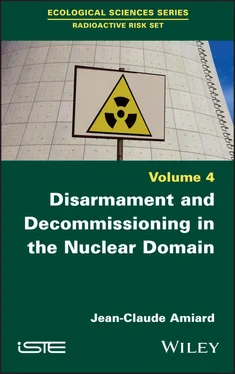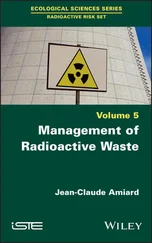301 300
302 301
303 302
304 303
305 304
306 305
307 306
308 307
309 308
310 309
311 310
312 311
313 312
314 313
315 314
316 315
317 316
318 317
319 318
320 319
321 320
322 321
323 322
324 323
325 324
326 325
327 326
328 327
329 328
330 329
331 330
332 331
333 333
334 334
335 335
336 336
337 337
338 338
Radioactive Risk Set
coordinated by
Jean-Claude Amiard
Disarmament and Decommissioning in the Nuclear Domain
Volume 4
Jean-Claude Amiard

First published 2021 in Great Britain and the United States by ISTE Ltd and John Wiley & Sons, Inc.
Apart from any fair dealing for the purposes of research or private study, or criticism or review, as permitted under the Copyright, Designs and Patents Act 1988, this publication may only be reproduced, stored or transmitted, in any form or by any means, with the prior permission in writing of the publishers, or in the case of reprographic reproduction in accordance with the terms and licenses issued by the CLA. Enquiries concerning reproduction outside these terms should be sent to the publishers at the undermentioned address:
ISTE Ltd
27-37 St George’s Road
London SW19 4EU
UK
www.iste.co.uk
John Wiley & Sons, Inc.
111 River Street
Hoboken, NJ 07030
USA
www.wiley.com
© ISTE Ltd 2021
The rights of Jean-Claude Amiard to be identified as the author of this work have been asserted by him in accordance with the Copyright, Designs and Patents Act 1988.
Library of Congress Control Number: 2021938220
British Library Cataloguing-in-Publication Data
A CIP record for this book is available from the British Library
ISBN 978-1-78630-721-7
Nuclear energy is used in two main areas: military and civil. In the military field, nine countries are currently manufacturing nuclear weapons of mass destruction, which is a serious threat to humanity and all living beings. Therefore, the UN and many NGOs are working to limit nuclear proliferation, as well as to limit the number of nuclear weapons. The ultimate goal, probably utopian, is a complete eradication of these weapons. Like all human creations, the life span of nuclear weapons is limited. The military must therefore deconstruct obsolete weapons and, unfortunately, manufacture new ones that are more powerful, more precise and therefore more destructive than previous ones. The military must also urgently clean up old nuclear facilities that have become obsolete, as well as highly contaminated.
In the civil field, nuclear energy is mainly used to produce electricity and in many medical applications for diagnostic or therapeutic purposes, with radiotracers (scintigraphy) and ionizing radiation destroying cancer cells (brachytherapy and radiotherapy). Here again, various nuclear installations, nuclear power reactors, plants, particle accelerators, etc. have a limited lifespan and must be decommissioned and dismantled. However, these operations are long, costly and present both environmental and health risks. They must therefore be carefully programmed, seriously supervised and controlled. The ideal is for the site to return to its initial state (often called “greenfield”).
The aim of this book, the fourth in the “radioactive risk” series, is to take stock of the state-of-the-art nuclear disarmament and dismantling. As with the previous works in this series, we have tried to use multiple information sources and verify them, in order to get as close as possible to the truth.
The first part of this book is devoted to the international efforts to limit nuclear proliferation, with various international treaties signed and some ratified, as well as agreements to limit the number of nuclear weapons held by the nuclear powers.
The second part deals with the decommissioning and dismantling of various types of nuclear facilities, including power, prototype and research reactors, as well as plants upstream and downstream of the nuclear fuel cycle or nuclear research centers.
May 2021
Jean-Claude Zerbib, a former CEA Senior Expert and radiation protection engineer, had the difficult task of reading, annotating and criticizing the original manuscript. He also provided me with the precious documents needed to complete the abundant literature that fed the writing of this book.
Professor Philip Rainbow (former Keeper of Zoology, Natural History Museum, London, UK) has done the same for the English version. I would like to thank them both for their time and effort.
I would also like to thank the members of the ANCCLI Scientific Council who helped me to understand certain subjects. The same goes for all of the members of the Groupe Radioécologie Nord Cotentin (GRNC), a pluralist group, for the remarkable work they carried out together courteously.
1
Nuclear Non-Proliferation
1.1. Introduction
Nuclear weapons pose an immense risk to human beings, as well as to all living beings and to the environment. For this reason, many individuals and organizations have been working to limit the number of states capable of manufacturing this type of weapon.
UN efforts to prevent, or at least limit, nuclear proliferation are significant and ongoing. For example, the UN Security Council Resolution 1540 (April 28, 2004) echoes the terms of the UN Security Council’s statement from January 31, 1992 by stating that “the proliferation of nuclear, chemical and biological weapons, as well as their means of delivery constitutes a threat to international peace and security”. However, in this resolution, it is the risks associated with the acquisition of such weapons by “non-state actors” that are specifically targeted. Some analysts consider that this resolution may justify the use of force to combat proliferation [IRS 19b].
Unfortunately, and in spite of its efforts for 35 years, it is obvious that the UN’s policy of nuclear disarmament has been a failure. The traditional vision of security that seems to be shared by the actors involved in the process of arms control and nuclear disarmament limits their capacity and willingness to abolish this type of armament [LAZ 06]. Hence, France and the United States are exerting strong pressure on the French-speaking states and on Japan to not sign the treaty on the Prohibition of Nuclear Weapons (TPNW).
In an interview with the IRIS ( Institut de Relations Internationales et Stratégiques , the French Institute for International and Strategic Affairs), Jean-Marie Collin [COL 18b], expert and spokesman for ICAN FRANCE, an organization awarded the Nobel Peace Prize in 2017, noted that nuclear weapons constitute a permanent and very real danger for the international community; otherwise, no treaty would have been signed at the UN, and the nuclear deterrent would be null and void. The International Committee of the Red Cross (ICRC) has stressed that no international plan or actor will be able to adequately address the needs of victims in the event of the use of nuclear weapons.
Nuclear weapons operate on the balance of terror. However, the problem with balance is that the risk of falling is always great. This “balance” is undesirable to an overwhelming majority of the world, because their security is directly at stake [COL 18b].
Читать дальше












